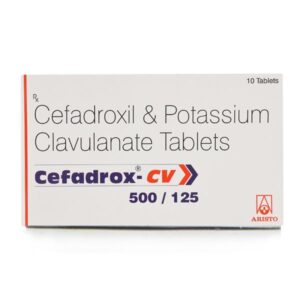CEFADROXIL + CLAVULANIC ACID
Cefadroxil: Cefadroxil is a prescription medication that belongs to the class of drugs known as cephalosporin antibiotics. It is commonly used to treat various bacterial infections, including skin infections, urinary tract infections, respiratory tract infections, and other infections caused by susceptible bacteria.
The mechanism of action of cefadroxil involves inhibiting the synthesis of bacterial cell walls, leading to the disruption of the bacteria’s ability to grow and spread. This helps in eliminating the infection and relieving the associated symptoms.
The usual recommended dose of cefadroxil for adults is 1 to 2 grams per day, divided into two doses taken every 12 hours. For children, the prescribed dose is based on their weight. It is important to follow the dosage instructions provided by your healthcare professional.
As with any medication, cefadroxil can cause side effects. Common side effects may include nausea, vomiting, diarrhea, stomach pain, headache, or skin rash. If any of these side effects persist or worsen, it is important to notify your doctor.
In rare cases, cefadroxil can cause severe allergic reactions, such as hives, itching, swelling, difficulty breathing, or dizziness. If you experience any of these symptoms, seek immediate medical attention.
Additionally, cefadroxil may sometimes lead to overgrowth of non-susceptible bacteria or fungi, which can cause secondary infections. It is important to report any new symptoms or worsening of symptoms to your healthcare professional.
It is crucial to complete the full course of cefadroxil as prescribed by your doctor, even if you start feeling better before finishing the medication. Stopping the medication prematurely may allow the bacteria to multiply and the infection to return.
Please note that this information is not exhaustive, and it is essential to consult your healthcare provider or pharmacist for personalized advice regarding the use of cefadroxil.
Clavulanic Acid: Clavulanic Acid is a drug that is commonly used in combination with antibiotics to enhance their effectiveness against certain types of bacteria. It belongs to a class of drugs known as beta-lactamase inhibitors.
The main use of Clavulanic Acid is to overcome the resistance that some bacteria have developed against beta-lactam antibiotics, such as penicillin and amoxicillin. These antibiotics are commonly used to treat bacterial infections, but some bacteria produce beta-lactamase enzymes that inactivate these antibiotics. Clavulanic Acid works by inhibiting these enzymes, allowing the antibiotic to effectively kill the bacteria.
Clavulanic Acid is not typically used alone as a stand-alone antibiotic. It is usually combined with an antibiotic, such as amoxicillin, and is available in various formulations, including tablets, capsules, and oral suspensions.
The dose of Clavulanic Acid varies depending on the specific formulation and the antibiotic with which it is combined. It is important to follow the prescribed dose and duration of treatment recommended by a healthcare professional.
Like any medication, Clavulanic Acid can cause some side effects. Common side effects may include diarrhea, nausea, vomiting, abdominal pain, and allergic reactions such as rash or itching. It is important to report any severe or persistent side effects to a healthcare professional.
In summary, Clavulanic Acid is a medication used to enhance the effectiveness of certain antibiotics by inhibiting bacteria-produced enzymes that can inactivate these antibiotics. It is usually combined with an antibiotic and is primarily used to treat bacterial infections. It is important to use Clavulanic Acid as prescribed and to be aware of potential side effects.

